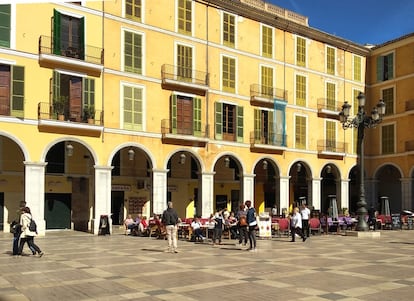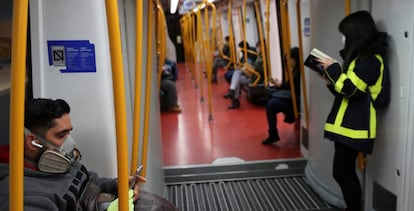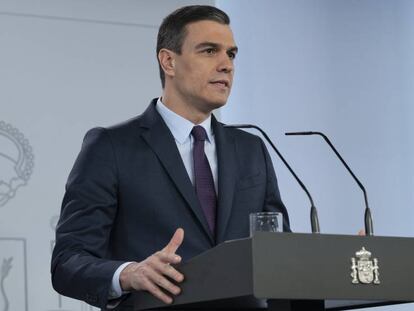Spain’s deescalation measures – what we know so far
Prime Minister Pedro Sánchez announced that the return to a “new normality” would involve a series of phases, with no set dates and differing from province to province if necessary
The much-awaited deescalation of Spain’s coronavirus confinement measures will allow for citizens to recover their freedom of movement, but bit by bit. No travel will be permitted to other provinces, without justification (such as to work), at least until the end of June. Until then, traveling to another part of Spain to visit relatives or for leisure will not be allowed.
Phase 0
This phase will be one of preparation, and will see citizens able to go outside for exercise or for walks from this weekend onward. The government is yet to publish the details of the conditions for these trips out onto the street.
Individual training will also be permitted for professional sportsmen and women, as well as basic training for professional leagues.
Small businesses will be able to open if they can offer appointments, such as hardware stores or restaurants that offer food to take away.
You will also be able to book appointments at the hairdresser from this coming Monday onward. Staff in such establishments will have to wear protective equipment, such as masks and gloves.
Phase 1
From May 10, when Phase 1 of the government’s plan is due to begin, journeys to second residences will be allowed providing that they are in the same province, but if they are in a different province, such trips will not be allowed until at least the end of June.
What’s more, the government is recommending the use of masks on public transport, where it is not always possible to maintain a distance of two meters with other travelers.
Phase 1 is likely to be implemented from May 4 in Formentera (Balearic Islands), La Gomera, El Hierro and La Graciosa (Canary Islands), due to the low transmission rate of the coronavirus there.

During Phase 1, social contact between people in the same city who are not considered to be at risk – i.e. the elderly and people with underlying conditions – will be possible.
You will also be able to travel in a car with the people you live with under the conditions of Phase 1.
Sidewalk cafés will be able to open, albeit at 30% of their usual capacity. This means that you will be able to have a drink with friends on a terrace, but not visit your family members in another province.
You will also be able to meet with friends or family in their homes if they are in the same province, but the details of how many people can meet and the conditions are yet to be determined.
Hotels will also be able to reopen, but there will be no common areas available to guests, such as the buffet.
Phase 2
The government has not set specific dates for each phase, and implementation could vary from province to province depending on the situation of the outbreak. But when Phase 2 arrives, citizens will be able to enter the inside of bars and restaurants, with a limit of 30% of capacity. Cinemas, theaters and auditoriums will also reopen with a similar limit on capacity, as well as monuments and exhibition centers.
At this point, cultural events such as concerts will be possible, albeit with a third of their usual capacity. At outdoor events, up to 400 people will be allowed, provided they are seated.
Visits to people in homes with disabilities will be allowed, but not to seniors.
Schools will offer classes for the children under the age of six if their parents require it to be able to go to work, while students will also be able to complete their university entrance exams.
Schools in Spain will not reopen fully until September.
Phase 3
Phase 3 will see the relaxation of mobility restrictions, albeit with a continued recommendation to wear masks outside of the home, and above all, on public transport. This phase is likely to be implemented in mid-June, and will allow for visits to senior homes, under conditions that will be established at a future date. Bars will be able to open with a limit of 50% of capacity.

As for beaches and swimming pools, there will be more details on their use specified in the future. Shoppers will be able to enter establishments, but there will be a limit on capacity and they will have to observe social distancing of two meters.
Nightclubs and nighttime bars are also due to open under Phase 3, albeit with capacity limited to a third.
“New normality”
The last stage – referred to by the government as “the new normality” – should arrive at the end of June provided there is no upsurge of the virus. “Mobility between provinces will arrive when we get to the new normality,” said Prime Minister Pedro Sánchez at a press conference on Tuesday evening.
But some provinces could get to this stage before others, meaning that travel between them will only be possible if they are both in the same situation.
There has, as yet, been no confirmation of when national flights and non-essential train journeys will be possible once more.
“We want to highlight the use of other plans for mobility in our plans, reclaiming urban spaces for pedestrians and bicycles in order to avoid a rise in the use of private vehicles and a worsening of noise levels, air quality and traffic jams,” the prime minister said on Tuesday.
The executive is planning on recommending the use of bikes, public spaces for those on foot, as well as other measures including home working where possible, and staggered start times in workplaces to avoid crowds on public transport.
The markers for each change of phase will depend on:
- The strategic capacity of Spain’s health system, including primary care, the situation in hospitals and the number of intensive care unit (ICU) beds available.
- The epidemiological situation, including testing, the infection rate and other indicators.
- The collective compliance with protection measures in the workplace, businesses and public transport.
- The evaluation of mobility and socioeconomic data.
English version by Simon Hunter.
Tu suscripción se está usando en otro dispositivo
¿Quieres añadir otro usuario a tu suscripción?
Si continúas leyendo en este dispositivo, no se podrá leer en el otro.
FlechaTu suscripción se está usando en otro dispositivo y solo puedes acceder a EL PAÍS desde un dispositivo a la vez.
Si quieres compartir tu cuenta, cambia tu suscripción a la modalidad Premium, así podrás añadir otro usuario. Cada uno accederá con su propia cuenta de email, lo que os permitirá personalizar vuestra experiencia en EL PAÍS.
En el caso de no saber quién está usando tu cuenta, te recomendamos cambiar tu contraseña aquí.
Si decides continuar compartiendo tu cuenta, este mensaje se mostrará en tu dispositivo y en el de la otra persona que está usando tu cuenta de forma indefinida, afectando a tu experiencia de lectura. Puedes consultar aquí los términos y condiciones de la suscripción digital.








































